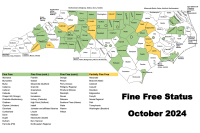A telling tale
“Gambling on a Ghost Bird” in the current issue of the journal Science (www.sciencemag.org/cgi/content/full/5840/888/F1 - there’s a $10 fee) regarding the “rediscovery” of the ivory-billed woodpecker in 2004 and the subsequent lack of documentation, makes for a very interesting read.
After all it was Science that announced to the world on April 28, 2005, “Ivory-billed Woodpecker (Campephilus principalis) Persists in Continental North America.” And the article’s author, Erik Stokstad, is no outsider to Science. He is the editor of SCIENCENOW, Science’s online news service.
One of the nagging questions I have had since the heralded announcement of the ivory-billed’s rediscovery is how such an astounding claim – “...the conservation story of the century...” – offering such a paucity of hard evidence could get the play this story did. Stokstad points to John Fitzpatrick, director of the prestigious Cornell Laboratory of Ornithology (CLO).
Stokstad describes Fitzpatrick as, “...shrewd, ambitious, and decisive.” And quotes Frank Gill, retired chief scientist of the National Audubon Society: “’He [Fitzpatrick] can move mountains in a way that no other ornithologist can do.’”
Also puzzling is the fact that Fitzpatrick decided to take the mountain to Mohammed based on the word of his friend Tim Gallagher, author of The Grail Bird and editor of Cornell’s Living Bird magazine, who convinced Fitzpatrick that he and fellow ivory-billed hunter Bobby Harrison had seen the bird themselves. According to Stokstad, Fitzpatrick declared, “I have to put my faith in those people able to separate fact from fiction.”
And like the relief pitcher who wants to be called to the mound in the bottom of the ninth of the seventh game of the World Series with the bases loaded, no outs and a one-run lead, it appears Fitzpatrick relished the opportunity to move “Mount Ivory-billed.” ”’Nobody else had the balls to do it,’ Fitzpatrick says,” writes Stokstad in the article.
Related Items
Seeing how the D.C. press conference announcing the rediscovery came to be and what further searches have yielded, one has to wonder whether this determined panache got in the way of sound judgment and good science. The article notes that Fitzpatrick and Cornell mounted a search in the spring of 2004, following Gallagher’s pronouncement. The search was a clandestine operation — searchers had to sign confidentiality documents and locals were told that the searchers were doing a biological inventory for The Nature Conservancy. According to the article, there was a flurry of sightings in early April when the search began. However when Jeffrey Wells, Cornell’s logistical manager for the search, decided to pair observers for better quality control, the sightings stopped; all but the one by avowed ivory-billed searcher David Luneau and his brother-in-law that produced the infamous four seconds of blurry video.
Fitzpatrick didn’t like the video’s quality, but by February 2005, according to Stokstad, Fitzpatrick, “... realized that ‘we need to act as though the Luneau video plus sightings plus sound is going to be enough.’”
So after two years of searching and nothing new, the mountain mover went to work. Fitzpatrick contacted former CLO assistant director James Tate who just happened to be science advisor to Gale Norton, Secretary of the Department of Interior (at the time.)
Stokstad writes, “’We wanted to get as much buy-in from the government to put money into conservation of this area as we could,’ Fitzpatrick says.”
Fitzpatrick had hoped for an announcement at the end of the 2004-2005 search season. He had contacted Donald Kennedy, editor of Science about a paper and Kennedy noted that he responded, “in a New York second.” The paper went out for review in early April with a tentative mid-May publish date. However, word of the search and the paper leaked on April 25, 2005 and in a maelstrom uncommon in academia and politics the paper and blurry video were published online by Science on April 28, 2005, the same day the press conference was held in D. C.
While the congratulatory hoopla was still in high gear some ornithologists were looking at the blurry video and scratching their heads. One of those head-scratchers was Dr. Jerome Jackson of Florida Gulf Coast University and regarded by many as one of the world’s foremost authorities on the ivory-billed woodpecker. Jackson, Mark Robbins, Richard Prum and Brett Benz authored a paper that was to be published online in PloS Biology stating that they felt the bird in the blurry video was actually a pileated woodpecker. According to Stokstad, as the paper languished awaiting publication, “... Tate called Jackson on a Saturday night and told him to ‘back off.’ Tate denies that and says he just wanted to discuss Jackson’s criticisms.” With Jackson out of the country, Fitzpatrick and Cornell approached Prum and Robbins with audio recordings they claimed to be ivory-billed woodpeckers. Cornell latter admitted that none of the hundreds of thousands of hours of recordings could absolutely be attributed to ivory-billeds. However, the recordings caused Prum and Robbins to withdraw the paper. ‘”I blinked,’ Prum says,” is how Stokstad noted it in the article.
Jackson didn’t blink and in January 2006 published, in the Auk, an article questioning the rediscovery.
Stokstad writes, “After another round of rebuttals commenced, Fitzpatrick confronted Jackson during an August 2006 meeting in South Carolina and asked him not to publish. Jackson recalls Fitzpatrick heatedly telling him, ‘“You are going to be independently responsible for the extinction of the ivory-billed woodpecker because you are preventing me from raising money for conservation.’” Shortly thereafter, Fitzpatrick contacted Jackson again and offered co-authorship on a future paper if Jackson would pull his letter. ‘“That’s not how I operate,’” Jackson told him.”
After two more years of searching Cornell has failed to come up with anything more definitive than the Luneau video. But that doesn’t deter Fitzpatrick. “Fitzpatrick still believes his team saw an ivorybill, although he never did himself, in the Big Woods in both 2004 and early 2005, and he speculates that it has either flown elsewhere or died,” writes Stokstad and quotes Fitzpatrick, ‘“I move with the actions that I deem appropriate for the possibility that the birds are there,’ he says. ‘And I don’t look back.”’
While one bird can conveniently fly away or die. Where does that leave Geoff Hill of Auburn and his Choctawhatchee search? Remember Hill claimed that there might be as many as nine pairs of ivory-billeds along the Choctawhatchee and that he had seen one and that he would get a clear photo. However, all Hill et al could muster at this year’s recent American Ornithologists’ Union annual meeting were reports of more brief sightings, intriguing recordings, interesting cavities and another Bigfoot video. Oh well, I guess 18 more could have died in Florida.









